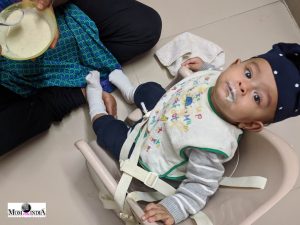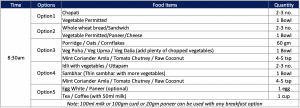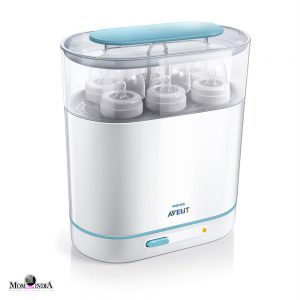Introducing your little one to solids is exciting- from breast milk/formula, to a whole new world of flavours. Six months of age is usually recommended to start this journey, as breast milk meets all the nutritional needs of your baby. However as the baby grows, sometimes a mother might feel that her milk supply isn’t being able to satiate the baby’s hunger. Even after the regular feeds, the baby might continue to cry or be irritable. This developmental change can happen due to many reasons, hence it’s best to watch out for these 7 signs to understand whether your baby is ready to start on solids.
Before I list the signs, a word of caution- do not introduce solids to a baby less that 4 months. The baby’s body needs its nutrition in an easily digestible form. Mother’s milk is apt and enough for the baby. Hastening the process by starting solids earlier than this age will be detrimental to the baby’s health. If your baby is older than 4 months and is showing signs of wanting solid food, do consult your paediatrician. Every baby is unique and so is its development. Keeping your medical practitioner informed before starting a new phase is always prudent.
The 7 Signs to take a note of:
 1. The baby can support its head: A baby’s neck need to adapt to support the weight of its head, to enable proper passage of solid food into its body. If your baby can hold its head and look around, chances are that it’s prepared to start this new phase.
1. The baby can support its head: A baby’s neck need to adapt to support the weight of its head, to enable proper passage of solid food into its body. If your baby can hold its head and look around, chances are that it’s prepared to start this new phase.
2. The baby can sit upright: While there are some babies who can sit up by themselves even after six months, the ability to sit by themselves indicates that its body is gearing up to digest solid food. If your baby can sit ,even with assistance, like with straps on a high chair, it is possibly ready to embark to the next level of the feeding journey.
 3. Mimicking Chewing: Keep a note of whether your baby is mimicking the action of chewing. To act like it’s chewing, the baby’s jaws have to be developed enough. Without naturally being comfortable with the action, it would be difficult for the baby to assimilate the food.
3. Mimicking Chewing: Keep a note of whether your baby is mimicking the action of chewing. To act like it’s chewing, the baby’s jaws have to be developed enough. Without naturally being comfortable with the action, it would be difficult for the baby to assimilate the food.
4. Displaying curiosity towards food: If your baby displays interest or reaches out to the food that you eat, it’s a wonderful sign to understand that it is looking forward to upgrade its taste profile. However babies are naturally curious so it may not be the only indicator.
 5. Body weight has doubled since birth: Before starting your baby on solids note that its body weight must have doubled from its birth weight. This validates the fact that its body has grown enough to bear the changes that might occur once solids are introduced. This also ensured that the baby’s growth is not affected should it drink less milk during this transition.
5. Body weight has doubled since birth: Before starting your baby on solids note that its body weight must have doubled from its birth weight. This validates the fact that its body has grown enough to bear the changes that might occur once solids are introduced. This also ensured that the baby’s growth is not affected should it drink less milk during this transition.
6. Tongue Reflex: Babies have a reflex action that looks like they are spitting out. If your baby is ready for solids, there would be a decrease in it sticking out it’s tongue. Like suckling milk, a natural control over this reflex would indicate that baby is now ready to hold food in its mouth.
 7. The baby is hungry even after a feed: This is the most important sign of all, as they grow their meal requirements increase & that affects their diet. If your baby seems to be hungry more often than before, even though you have been maintaining the feeding cycles, it is a key indicator that the baby needs more than milk.
7. The baby is hungry even after a feed: This is the most important sign of all, as they grow their meal requirements increase & that affects their diet. If your baby seems to be hungry more often than before, even though you have been maintaining the feeding cycles, it is a key indicator that the baby needs more than milk.
Observe your baby. If your baby is demonstrating the above points, this is your cue to consult your doctor. Do note that breast milk/formula, is still the primary source of nutrition for your little one. Before one solids are just for fun. Solid food at this stage are not “solids” in terms of form. Introductory food are mostly liquids or semi liquid. To know about what “solid food” to start with, do check this link (Click on this Link). This content is also available in a video format (Click on this Link)
We as parents tend to stress out while noting the milestones of our baby. Every baby grows at its own pace. Instead of checklists of growth markers, focusing on the day to day happiness of parenting opens a world of happiness. Feel free to reach out to me with your doubts ,comments, feedbacks and share any anxieties that you may feel. Be it on any of the platforms- YouTube, Instagram, Facebook, Twitter or our website, I am here to support you. By sharing articles like this, with fellow parents and caregivers, we build a community that is dedicated to raising happy children. And while at it, enjoy simplified parenting.
♥♥6 महीने के पास आके बच्चों का ठोस आहार शुरू हो जाता है, इस आर्टिकल में जाने की क्या आपका बच्चा ठोस आहार के लिए तैयार है? | इस आर्टिकल की जानकारी हिंदी में पाने के लिए नीचे दिए वीडियो को देखें ►









 My doctor first explained the cause of this hair fall. Hair has its own cycle. The three stages that mark this cycle are Growth , Rest and Fall. In the growth stage, we see “new hair” and the growing of hair. The Rest stage holds the hair as it is. And the fall stage marks the falling of the hair. This cycle keeps repeating itself. Normally this would continue at its own pace. However, pregnancy changes the hormonal balance. Estrogen peaks the charts. The hormone Estrogen locks the hair in Rest stage. Hence there isn’t any hair fall. Post-delivery, there is sharp drop in Estrogen. The hair which for all these months was in a perpetual “rest stage ”, now graduates to the “fall stage”. It’s this collective falling after the months of pregnancy, that alarms us. Understanding the hair cycle and its changes due to Estrogen, highlights a key fact- Post-delivery hair fall is normal.
My doctor first explained the cause of this hair fall. Hair has its own cycle. The three stages that mark this cycle are Growth , Rest and Fall. In the growth stage, we see “new hair” and the growing of hair. The Rest stage holds the hair as it is. And the fall stage marks the falling of the hair. This cycle keeps repeating itself. Normally this would continue at its own pace. However, pregnancy changes the hormonal balance. Estrogen peaks the charts. The hormone Estrogen locks the hair in Rest stage. Hence there isn’t any hair fall. Post-delivery, there is sharp drop in Estrogen. The hair which for all these months was in a perpetual “rest stage ”, now graduates to the “fall stage”. It’s this collective falling after the months of pregnancy, that alarms us. Understanding the hair cycle and its changes due to Estrogen, highlights a key fact- Post-delivery hair fall is normal. 4. Get a Haircut
4. Get a Haircut










 This is as per personal preference or necessity. However, the earlier a bottle is introduced to a baby, the lesser the chance of the baby rejecting it. Nipple confusion is rare and can be avoided by choosing the right bottle for the baby. Both Dr Brown and Philips Avent, are designed to mimic the feel of a mother’s nipple.
This is as per personal preference or necessity. However, the earlier a bottle is introduced to a baby, the lesser the chance of the baby rejecting it. Nipple confusion is rare and can be avoided by choosing the right bottle for the baby. Both Dr Brown and Philips Avent, are designed to mimic the feel of a mother’s nipple.
 a. ORS Solution: First and foremost, ORS is the primary aid to reduce Diarrhoea. As the baby passes watery stool, there is a significant loss of water and salts from the body. The main goal at this time is to keep the baby hydrated. ORS replenishes the loss of salt and water in a baby’s body. The measure advised is 5ml per Kg. Hence, if your child is 10kgs, then 50ml of ORS should be given, per serving. Every-time the baby passes a watery stool, ORS should be given to balance the loss.
a. ORS Solution: First and foremost, ORS is the primary aid to reduce Diarrhoea. As the baby passes watery stool, there is a significant loss of water and salts from the body. The main goal at this time is to keep the baby hydrated. ORS replenishes the loss of salt and water in a baby’s body. The measure advised is 5ml per Kg. Hence, if your child is 10kgs, then 50ml of ORS should be given, per serving. Every-time the baby passes a watery stool, ORS should be given to balance the loss. c. Change in Diet is an obvious necessity. Like adults the babies too need to have easily digestible sources of nutrition. Breast milk is the best in this stage. Formula milk is heavier. At least for the first 3-4 days, one needs to stop formula milk.
c. Change in Diet is an obvious necessity. Like adults the babies too need to have easily digestible sources of nutrition. Breast milk is the best in this stage. Formula milk is heavier. At least for the first 3-4 days, one needs to stop formula milk.